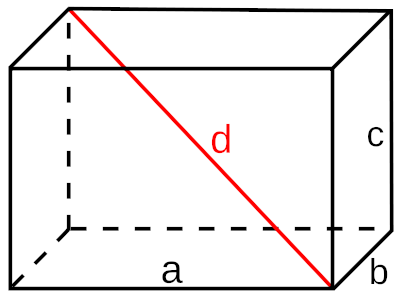
You have three identical bricks and a ruler. How can you determine the length of a brick’s interior diagonal without any calculation?

You have three identical bricks and a ruler. How can you determine the length of a brick’s interior diagonal without any calculation?
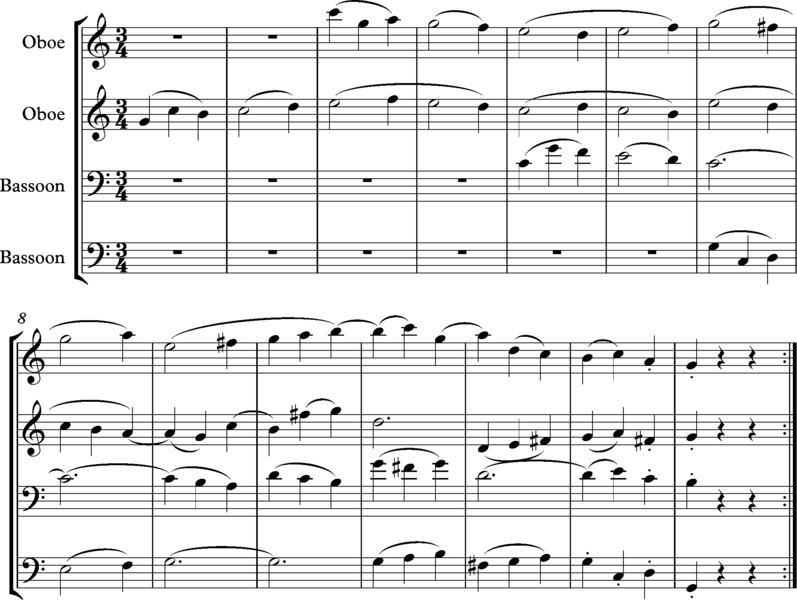
The trio section of Mozart’s Serenade for Wind Octet in C, K. 388 (audible here at 14:30), is a double mirror canon: The second oboe introduces a line and after two bars the first oboe joins it playing the same line “upside down”; then the first bassoon starts its own line and the second bassoon enters playing that upside down. Now all four parts are exploring the same theme, but they’re offset by two bars apiece and two of them are inverted.
Pianist Erik Smith called this “the visual image of two swans reflected in the still water,” “a perfect example of Mozart’s use of academic means, canon, inverted canon and mirror canon, to a purely musical and emotional end.”
A curious puzzle from Pi Mu Epsilon Journal, Fall 1968 [Volume 4, Issue 9]:
Where must a man stand so as to hear simultaneously the report of a rifle and the impact of the bullet on the target?
Holders of lottery tickets are reluctant to trade them in for different tickets, even though they know that all tickets are equally likely to win. Why? Possibly it’s because of “anticipated regret” — I’ll feel like a fool if I discover I’ve traded away a winning ticket; I’d rather hold on to my ticket even if it means that my inaction costs me a fortune.
But in a series of experiments in 2007, Cornell psychologists Jane Risen and Thomas Gilovich found that people have a gut feeling that an exchanged lottery ticket is more likely to win than an unexchanged one, and are even willing to back up that belief with cash. We seem to find it easy to imagine that possibility, and that ease makes that outcome seem more likely.
“As these results indicate, the tendency to imagine a negative outcome and therefore to believe that it is especially likely to occur manifests itself in many other circumstances beyond the decision of whether to exchange lottery tickets.” For example, we think we’re more likely to be pulled over by police when we’ve borrowed a car without permission, and we think we’re more likely to be called on in class when we haven’t done the reading.
For similar reasons, people are reluctant to switch checkout lanes at the grocery store or to change answers on a multiple-choice test. “Although one might think that in most situations the rational system would hold the upper hand, it is often the intuitive system that people obey.”
(Jane L. Risen and Thomas Gilovich, “Another Look at Why People Are Reluctant to Exchange Lottery Tickets,” Journal of Personality and Social Psychology 93:1 [2007], 12.)
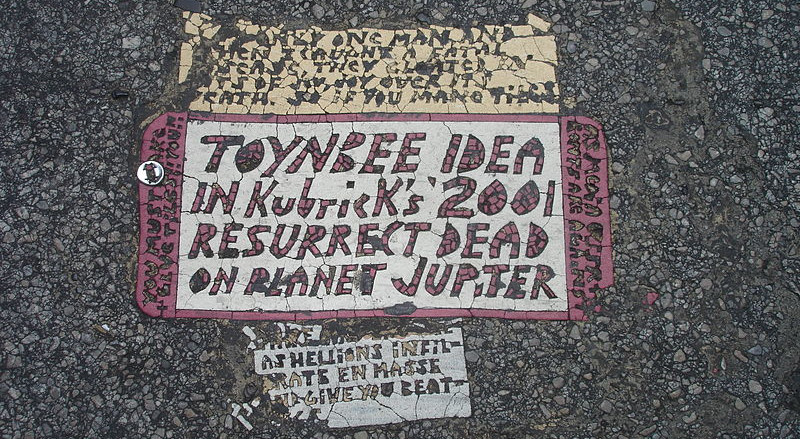
What is this? No one quite knows. Plaques such as this have been found embedded in the streets of 24 major American cities since the late 1980s. Typically they read:
TOYNBEE IDEA
IN MOViE `2001
RESURRECT DEAD
ON PLANET JUPITER
But what that means, and who’s been placing them, are unknown. TOYNBEE may be British historian Arnold J. Toynbee, and MOViE `2001 is likely Stanley Kubrick’s 1968 film. What do these have in common? One possibility is Ray Bradbury’s 1984 short story “The Toynbee Convector,” which appeals to Toynbee’s idea that humans must adopt ambitious goals in order to advance even slightly (colonizing Jupiter might be such a goal). But that’s just a guess, and even if it’s right it’s not clear how someone thought that impressing it in asphalt would advance this cause. Maybe some sort of Phase 2 is coming.
In the spring of 1908, Max Beerbohm and Edmund Gosse sent a message back and forth, each adding a line until they had composed a sonnet to Henry James, whose incomprehensible novels they both admired. The odd-numbered lines are Beerbohm’s, the even-numbered Gosse’s:
To Henry James
Say, indefatigable alchemist,
Melts not the very moral of your scene,
Curls it not off in vapour from between
Those lips that labour with conspicuous twist?
Your fine eyes, blurred like arc-lamps in a mist
Immensely glare, yet glimmering intervene,
So that your May-Be and your Might-Have-Been
Leave us still plunging for the genuine gist.
How different from Sir Arthur Conan Doyle, —
As clear as water and as smooth as oil,
And no jot knowing of what Maisie knew!
Flushed with the sunset air of roseate Rye
You stand, marmoreal darling of the Few,
Lord of the troubled speech and single Eye.
“The sonnet was never shown to James himself,” writes J.G. Riewald in Max Beerbohm’s Mischievous Wit, “because, according to Max, ‘he would be too complex to understand our special brand of sincere reverence.'”
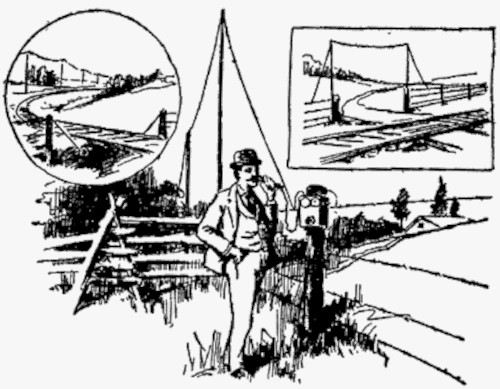
At the turn of the 20th century, rural cooperative associations found a way to install telephone networks without erecting poles: They simply connected their wires to the existing pasture fences.
“Fifteen or twenty farmers in Clay Township, Cass County, are enjoying the privileges of first-class telephone service without the annoyance of a monthly collector thrusting a bill for rental under their noses,” reported the Washington Post in 1903. “Their homes are connected by a system of wires, and the novelty of the plan lies in the fact that the barbed wire fences are utilized as a conveyor of neighborhood gossip. Just who conceived the idea that these strands of wire that for years had served only one purpose could be made to do a double duty is not known.”
Maude Smith Galloway and her husband arrived in Texas in 1906. “We talked to a few close neighbors over a telephone hooked to a barbed wire fence when we came to Llano,” she said, “and now we have the dial system and can talk to any of the rural districts in the country.”
Historian David B. Sicilia wrote, “Barbed wire unwittingly became part of the nation’s budding telephone network. What kept crops and animals apart helped bring people together.”
(Alan Krell, The Devil’s Rope, 2002.)
If you cannot understand my argument, and declare ‘It’s Greek to me’, you are quoting Shakespeare; if you claim to be more sinned against than sinning, you are quoting Shakespeare; if you recall your salad days, you are quoting Shakespeare; if you act more in sorrow than in anger, if your wish is father to the thought, if your lost property has vanished into thin air, you are quoting Shakespeare; if you have ever refused to budge an inch or suffered from green-eyed jealousy, if you have played fast and loose, if you have been tongue-tied, a tower of strength, hoodwinked or in a pickle, if you have knitted your brows, made a virtue of necessity, insisted on fair play, slept not one wink, stood on ceremony, danced attendance (on your lord and master), laughed yourself into stitches, had short shrift, cold comfort or too much of a good thing, if you have seen better days or lived in a fool’s paradise — why, be that as it may, the more fool you, for it is a foregone conclusion that you are (as good luck would have it) quoting Shakespeare; if you think it is early days and clear out bag and baggage, if you think it is high time and that that is the long and short of it, if you believe that the game is up and that truth will out even if it involves your own flesh and blood, if you lie low till the crack of doom because you suspect foul play, if you have your teeth set on edge (at one fell swoop) without rhyme or reason, then — to give the devil his due — if the truth were known (for surely you have a tongue in your head) you are quoting Shakespeare; even if you bid me good riddance and send me packing, if you wish I was dead as a door-nail, if you think I am an eyesore, a laughing stock, the devil incarnate, a stony-hearted villain, bloody-minded or a blinking idiot, then — by Jove! O Lord! Tut, tut! for goodness’ sake! what the dickens! but me no buts — it is all one to me for you are quoting Shakespeare.
— Bernard Levin, Enthusiasms, 1983
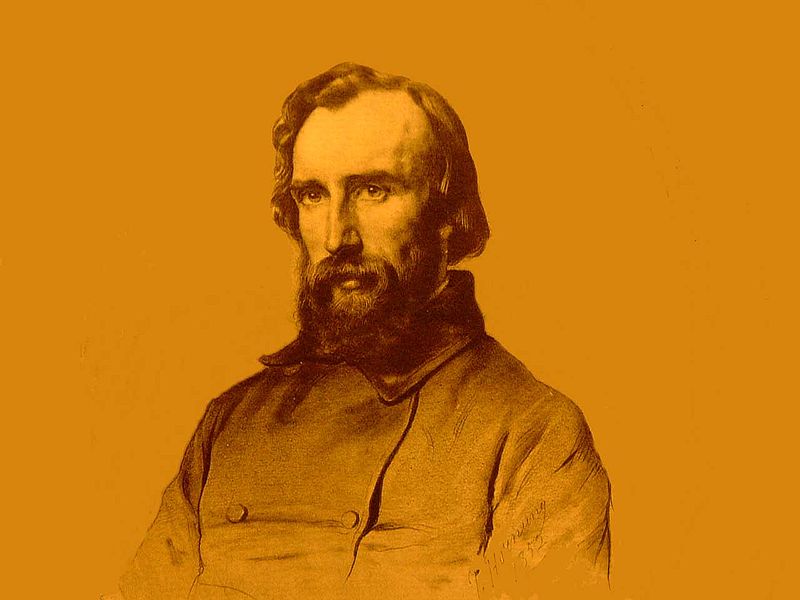
pathographesis
n. writing inspired by illness
After a shining start, Swiss philosopher Henri-Frédéric Amiel lost his patronage and his health, leaving him remembered largely for a private journal that became his only reality, the symptom and source of his illness. In the end it ran to 12 compulsively written volumes totaling 6 million words, a real-time description of its writer’s inner life:
He was slowly suffocating as he wrote his final entries — the last, written on April 19, 1881, reads, “A terrible sense of oppression. My flesh and my heart fail me. Que vivre est difficile, ô mon coeur fatigué!”
“We think our protagonist was virtually unique in the degree to which he turned his diary into a fetishistic addiction, not so different from the substance addiction common in his culture,” write George S. Rousseau and Caroline Warman. “His diary was his fix. Boundaries between himself and his diary are nonexistent. And his larger definition of life, or living, was so firmly fused with the diary that he could not conceive of life, or living, apart from it.”
(George S. Rousseau and Caroline Warman, “Writing as Pathology, Poison, or Cure: Henri-Frédéric Amiel’s Journal intime,” Studies in Gender and Sexuality 3:3 [2002], 229–262.)
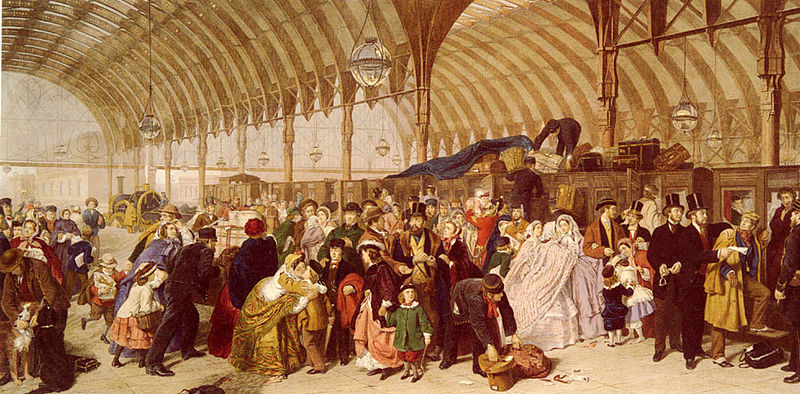
Is this art? It’s The Railway Station, painted by William Powell Frith in 1862. In his 1914 book Art, critic Clive Bell singled out Frith’s painting to claim that it wasn’t art at all. Why? Bell said it lacks “significant form,” which he defined as “lines and colours combined in a particular way, certain forms, and relations of forms, that stir our aesthetic emotions.” Frith’s painting, he said, provoked pleasant feelings in him but no aesthetic emotion:
Few pictures are better known or liked than Frith’s Paddington Station: certainly I should be the last to grudge it its popularity. Many a weary forty minutes have I whiled away disentangling its fascinating incidents and forging for each an imaginary past and an improbable future. But certain though it is that Frith’s masterpiece, or engravings of it, have provided thousands with half-hours of curious and fanciful pleasure, it is not less certain that no one has experienced before it one half-second of aesthetic rapture — and this although the picture contains several pretty passages of color, and is by no means badly painted. Paddington Station is not a work of art; it is an interesting and amusing document in which line and color are used to recount anecdotes, suggest ideas and indicate the manners and customs of an age: they are not used to provoke aesthetic emotion.
Was he right? Notably, in a 2012 survey of 105 art professionals, not one agreed with him: 97% of the respondents said they felt Frith’s painting was art, and the remaining 3% were unsure.
“Admittedly, these data do not prove that Bell’s theory is wrong,” the authors note. “The sensibilities required to detect significant form and experience the aesthetic emotion it provokes could be even rarer than Bell claimed.”
(Richard Kamber and Taylor Enoch, “Why Is That Art?”, in Florian Cova and Sébastien Réhault, Advances in Experimental Philosophy of Aesthetics, 2019.)